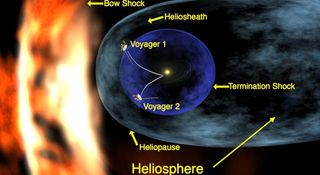Edge of Solar System Filled with Bubbles, NASA Says

The edge of our solar system is filled with a turbulent sea of magnetic bubbles, according to new NASA research.
Scientists made the discovery by using a new computer model, which is based on data from NASA's twin Voyager probes. The unmanned Voyager 1 and Voyager 2, which launched in 1977, are plying the outer reaches of our solar system, a region known as the heliosheath.
The new discovery suggests that researchers will need to revise their views about the solar system's edge, NASA officials said. A more detailed picture of this region is key to our understanding of how fast-moving particles known as cosmic rays are spawned, and how they reach near-Earth space.
Cosmic rays are a threat to astronauts, as they can slam into spaceflyers' cells and damage their DNA. Earth's atmosphere attenuates cosmic rays, shielding folks on the ground from their worst effects.
NASA hasn't revealed many details about the new find. The space agency will hold a media teleconference at 1 p.m. EDT on Thursday (June 9) to discuss it in more depth.
Participating in the teleconference are:
— Arik Posner, Voyager program scientist, Heliophysics Division, Science Mission Directorate, NASA Headquarters, Washington, D.C.
Get the Space.com Newsletter
Breaking space news, the latest updates on rocket launches, skywatching events and more!
— Merav Opher, assistant professor of astronomy, Boston University
— James F. Drake, professor of physics, University of Maryland
— Edward C. Stone, Voyager project scientist, professor of physics, Caltech
— Eugene Parker, professor emeritus of physics, University of Chicago
Voyager 1 is now about 11 billion miles (17.7 billion kilometers) from Earth, while Voyager 2 is about 9 billion miles (14.5 billion km) away. Voyager 1 is the most far-flung human-made object in the universe. [NASA's 10 Greatest Science Missions]
Follow SPACE.com for the latest in space science and exploration news on Twitter @Spacedotcom and on Facebook.
Join our Space Forums to keep talking space on the latest missions, night sky and more! And if you have a news tip, correction or comment, let us know at: community@space.com.

Space.com is the premier source of space exploration, innovation and astronomy news, chronicling (and celebrating) humanity's ongoing expansion across the final frontier. Originally founded in 1999, Space.com is, and always has been, the passion of writers and editors who are space fans and also trained journalists. Our current news team consists of Editor-in-Chief Tariq Malik; Editor Hanneke Weitering, Senior Space Writer Mike Wall; Senior Writer Meghan Bartels; Senior Writer Chelsea Gohd, Senior Writer Tereza Pultarova and Staff Writer Alexander Cox, focusing on e-commerce. Senior Producer Steve Spaleta oversees our space videos, with Diana Whitcroft as our Social Media Editor.
